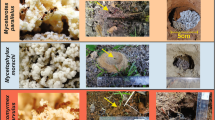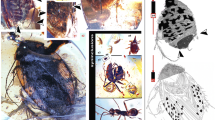Abstract
The question, when ants first appeared, remains unanswered. However, images of ants in Burmese amber show that some extinct types existed back then. By the mid-Cenozoic, most fossil ants could be assigned to extant genera. The present work examines ancient associations between ants and other organisms based on fossils in amber. Topics include fungal associates, interactions with higher plants, associations between ants and arachnids, ants bringing food to the colony, insect parasites and predators, nematode parasites, ants visiting flowers, ant mimics and gut microbes in ants. All specimens included in the present work are listed with the amber source, present location, published accounts and accession numbers of those in the Poinar amber collection (PAC).













































Similar content being viewed by others
References
Bell JV (1974) Mycosis. In: Cantwell GE (ed) Insect diseases. Marcell Dekker, New York
Benjamin RK (1973) Laboulbeniomycetes. In: Ainsworth GC, Sparrow FK, Sussman AS (eds) The Fungi, an advanced treatise. Academic Press, New York
Berg RD (1996) The indigenous gastrointestinal microflora. Trends Microbiol 4:430–435. https://doi.org/10.1016/0966-842x(96)10057-3
Berggren WA, Van Couvering JAH (1974) The late Neogene. Palaeogeo Palaeoclimat Palaeoecol 16:1–216
Blackwelder RE (1982) Checklist of the coleopterous insects of Mexico, Central America, The West Indies, and South America. Smithsonian Inst Bull 185(Parts 1–6):1-1492
Boucot AJ, Poinar GO Jr (2010) Fossil Behavior Compendium. CRC Press, Boca Raton
Brooks MA (1963) The microorganisms of healthy insects. In: Steinhaus EA (ed) Insect pathology; an advanced treatise, vol 1. Academic Press, London, pp 215–250
Caetano FH, Cruz-Landim C (1985) Presence of microorganisms in the alimentary canal of ants of the tribe Cephalotini (Myrmicinae): location and relationship with intestinal structure. Naturalia (São Paulo) 10:37–47
Comstock JH (1948) The spider book. Ithaca, Comstock Publishing Company, New York
Cruickshank RD, Ko K (2003) Geology of an amber locality in the Hukawng Valley, northern Myanmar. J Asian Earth Sci 21:441–455. https://doi.org/10.1016/S1367-9120(02)00044-5
De Vries PJ, Poinar GO Jr (1997) Ancient butterfly-ant symbiosis: direct evidence from Dominican amber. Proc R Soc London B 264:1137–1140
Dillon RJ, Dillon VM (2004) The gut bacteria of insects: nonpathogenic interactions. Annu Rev Entomol 49:71–92. https://doi.org/10.1146/annurev.ento.49.061802.123416
Gasque SN, Poinar GO, Fredensborg BL (2018) Ant (Hymenoptera: Formicidae) parasitism by Neoneurinae wasps (Hymenoptera: Braconidae) in Denmark. Entomol Medd 86:27–30
Haber WA, Frankie GW, Baker HG, Baker I, Koptur S (1981) Ants like flower nectar. Biotropica 13:211–214
Haelewaters D, van Wielink P, van Zuijlen JW, Verbeken A, De Kesel A (2012) New records of Laboulbeniales (Fungi, Ascomycota) from Dominican amber. Botany 91:530–553
Hölldobler B, Wilson EO (1990) The ants. Belknap Press, Cambridge
Iturralde-Vinent MS, MacPhee RDE (1996) Age and paleographic origin of Dominican amber. Science 273:1850–1852
Jacobson E (1911) Biological notes on the Hemipteron, Ptilocerus ochraceus. Tijdschr Entomol 54:175–179
Janzen DH (ed) (1983) Costa Rican natural history. University of Chicago Press, Chicago
LaPolla JS, Dlussy GM, Perricot V (2013) Ants and the fossil record. Annu Rev Entomol 58:609–630. https://doi.org/10.1146/annurev-ento-120710-100600
Orbán-Bakk K, Marczin MJ, Gál L, Heinze J, Csata E, Markó B (2022) Under pressure: the effect of long-term fungal infection on the encapsulation response in ants. Insect Soc 69:361–367. https://doi.org/10.1007/s00040-022-00879-z
Poinar G Jr (2012) Nematode parasites and associates of ants: past and present. Psyche 2012:192017. https://doi.org/10.1155/2012/192017
Poinar G Jr (2014) Pulchellaranea pedunculata n. gen., n. sp. (Araneae:Araneidae), a new genus of spiders with a review of araneid spiders in Cenozoic Dominican amber. Historical Biol 27:103–108
Poinar G Jr (2019) A Naturalist’s guide to plant communities of Pacific northwest dune forests and wetlands. BRIT Press, Fort Worth
Poinar G (2022) Flowers in Amber. Springer, Cham
Poinar GO Jr (1991) Praecoris dominicana gen. n., sp. n. (Hemiptera: Reduviidae: Holoptilinae) from Dominican amber, with an interpretation of past behavior based on functional morphology. Entomol Scand 22:193–199
Poinar GO Jr (2004) Behaviour and development of Elasmosoma sp. (Neoneurinae: Braconidae: Hymenoptera), an endoparasite of Formica ants (Formicidae: Hymenoptera). Parasitology 128:521–531. https://doi.org/10.1017/s0031182004004809
Poinar GO Jr (2011) The evolutionary history of nematodes. Brill, Leiden
Poinar GO Jr (2016) A naturalists guide to the secret world of the Pacific northwest dunes. Oregon State University Press, Corvallis
Poinar GO Jr, Chambers KL (2016) Mimosoideae (Fabaceae) diversity and associates in mid-tertiary Dominican amber. J Bot Res Inst Texas 10:121–136
Poinar G Jr, Columbus JT (2012) Alarista succina gen. et sp. nov. (Poaceae: Bambusoideae) in Dominican amber. Historical Biol 25:691–696. https://doi.org/10.1080/08912963.2012.742891
Poinar G Jr, Maltier Y-M (2021) Allocordyceps baltica gen. et sp. nov. (Hypocreales: Clavicipitaceae), an ancient fungal parasites of an ant in Baltic amber. Fungal Biol 125:886–890. https://doi.org/10.1016/j.funbio.2021.06.002
Poinar GO Jr, Miller J (2002) First fossil record of endoparasitism of adult ants (Formicidae: Hymenoptera) by Braconidae (Hymenoptera). Ann Entomol Soc Am 95:41–43. https://doi.org/10.1603/0013-8746(2002)095[0041:FFROEO]2.0.CO;2
Poinar GO Jr, Steeves R (2013) Virola dominicana sp. nov. (Myristicaceae) from Dominican amber. Botany 91:530–534
Poinar G Jr, Keven PG, Jackes BR (2016) Fossil species in Boehmerieae (Urticaceae) in Dominican and Mexican amber: a new genus (Ekrixanthera) and two new species with anemophilous pollination by explosive pollen release, and possible lepidopteran herbivory. Botany 94:599–606. https://doi.org/10.1139/cjb-2016-0006
Quevillon LE, Hughes DP (2018) Pathogens, parasites, and parasitoids of ants: a synthesis of parasite biodiversity and epidemiological traits. BioRxiv. https://doi.org/10.1101/384495
Rossi W, Kotrba M, Triebel D (2005) A new species of Stigmatomyces from Baltic amber, the first fossil record of Laboulbeniomycetes. Mycological Res 109:271–274
Sadowski E-M, Schmidt AR, Seyfullah LJ, Kunzmann L (2017) Conifers of the ‘Baltic amber forest’ and their palaeoecological significance. Stapfia 106:1–73
Schlee D (1990) Das Bernstein-Kabinett. Stuttgart Beiträge Natur (C) 28:1–100
Schuh RT, Slater JA (1995) True bugs of the world (Hemiptera: Heteroptera). Cornell University Press, New York
Segers FHID, Kaltenpoth M, Foitzik S (2019) Dominican microbial communities in ants depend on colony membeship rather than caste and are linked to colony productivity. Ecol Evol 9:13450–13467. https://doi.org/10.1002/ece3.5801
Shi G, Grimaldi DA, Harlow GE, Wang J, Wang J, Yang M, Lei W, Li Q, Li X (2012) Age constraint on Burmese amber based on U–Pb dating of zircons. Cretac Res 37:155–163. https://doi.org/10.1016/j.cretres.2012.03.014
Tavares II (1985) Laboulbeniales (Fungi, Ascomycetes) Mycologica memoirs. Braunschweig, Germany
Wasmann E (1932) Eine ameisenmordende Gastevanze (Proptilocerus dolosus n. g., n. sp.) im Baltischen Bernstein. Bernstein-Forsch 3:1–3
Wheeler WM (1910) Ants; their structure, development and behavior. Columbia University Press, New York
Yanoviak SP, Kaspari M, Dudley R, Poinar G Jr (2008) Parasite-induced fruit mimicry in a tropical canopy ant. Amer Nat 171:536–544. https://doi.org/10.1086/528968
Youngsteadt E, Baca JA, Osborne J, Schal C (2009) Species-specific seed dispersal in an obligate ant-plant mutualism. PLoS One 4:e4335. https://doi.org/10.1371/journal.pone.0004335
Funding
No funding was used in this study.
Author information
Authors and Affiliations
Corresponding author
Ethics declarations
Conflict of interest
The author has no conflicts of interest to declare.
Additional information
Publisher’s Note
Springer Nature remains neutral with regard to jurisdictional claims in published maps and institutional affiliations.
Appendix
Appendix
Subjects, accession numbers in the Poinar amber collection (PAC), amber sources, present location and published accounts
Fig. | Subject | Accession number | Amber source | Location/ reference |
|---|---|---|---|---|
1 | Cretaceous worker Sphecomyrmidae “ant” | Burmese | Buckley collection | unknown |
2 | Cretaceous alate Sphecomyrmidae ant with apparent fungal infection on abdomen | Burmese | Buckley collection | unknown |
3 | Laboulbeniales infection on ant | Sy- D- 1-22 | Dominican | PAC |
4 | Laboulbeniales on ant-detail | Sy- D- 1-22 | Dominican | PAC |
5 | Pandora sp. on abdomen of winged ant | Sy- D- 1-22 | Dominican | PAC |
6 | Beauveria sp. on Azteca alpha ant | AF-9-28 | Dominican | PAC |
7 | Allocordyceps baltica emerging from a Camponotus sp. ant | Maltier collection | Baltic | Poinar and Maltier (2021) |
8 | Ascoma of Allocordyceps baltica emerging from ant’s rectum | Maltier collection | Baltic | Poinar and Maltier (2021) |
9 | Trachymyrmex sp. gardening ant that was carrying a petal | Hy-10-189 | Dominican | PAC |
10 | Apterostigma sp. gardening ant that was carrying leaf portion | Hy-10-168 | Dominican | PAC |
11 | Queen Cyphomyrmex sp. that was carrying a bromatia from her fungus garden | Hy-10-177 | Dominican | PAC |
12 | Worker ant associated with a leaf | Baltic | PAC | |
13 | Harvester ant was probably carrying the Alarista succina spikelet | Sd-9-17 | Dominican | Poinar and Columbus (2012) |
14 | Harvester ant with Panicum floret | Sd-9-86 | Dominican | PAC |
15 | Mite attached to ant leg | Sy-1-19 | Baltic | PAC |
16 | Mite attached to ant thorax | Sy-1-19 | Baltic | PAC |
17 | Pseudomyrmex ant prey released by Pulchellaranea pedunculata spider | A-10-267 | Dominican | Poinar (2014) |
18 | Ant in spider web immersed in amber | Sy-1-58 | Dominican | PAC |
19 | Ant and pseudoscorpion | Sy-1-38 | Dominican | PAC |
20 | Ant and pseudoscorpion in combat | Sy-1-38 | Dominican | PAC |
21 | Alate ant carrying scale insect | Sy-10-99 | Dominican | PAC |
22 | Camponotus sp. that was attending aphids on mimosoid leaflet | Sd-9-195 | Dominican | PAC Poinar and Chambers (2016) |
23 | Azteca alpha ant that was attending aphids on mimosoid leaflet | Sd-9-195 | Dominican | PAC Poinar and Chambers (2016) |
24 | Worker ants carrying food item | Sy-1-41 | Dominican | PAC |
25 | Worker ant with termite head | Sy-1-92 | Dominican | PAC |
26 | Worker ant carrying ant larva | Sy-1-48 | Dominican | PAC |
27 | Neoneurine braconid parasite | Sy-1-149 | Baltic | PAC |
28 | Extant braconid parasite | Recent photo | Pacific coast | Poinar (2016) |
29 | Ant hemipteran predator, Praecoris dominicana | He-4-26 | Dominican | Poinar and Miller (2002) Poinar (1991) |
30 | Balloon secretory glands on Theope caterpillar | L-D-3-25 | Dominican | PAC DeVries and Poinar (1997) |
31 | Heydenius formicinus emerging from an alate ant | N-3-52 | Baltic | PAC |
32 | Juvenile Formicodiplogaster myrmenema emerged from between abdominal segments of Azteca alpha | N-3-18G | Dominican | PAC Segers et al. (2019) |
33 | Juvenile diplogastrids in head glands of Formica obscuriventris clivia | N-3-18B | Dominican | PAC |
34 | Extinct Cephalotus parasitized by Myrmeconema antiqua | N-3-75 | Dominican | PAC Poinar (2011) |
35 | Red abdomen of extant Cephalotus atratus parasitized by Myrmecoma neotropicum | Photo courtesy of S. Yanoviak | Dominican | Yanoviak et al. (2008) |
36 | Red fruits of Hyeronima alchorneoides closely resemble the red abdomen of Cephalotus atratus (arrow) infected with Myrmeconema neotropicum | Photo courtesy of S. Yanoviak | Dominican | Yanoviak et al. (2008) |
37 | Cephalotus ant visiting a flower of Virola dominicana | Sd-9-30 paratype | Dominican | PAC Poinar and Steeves (2013) |
38 | Crematogaster sp. ant visiting flowers of Klaprothiopsis dyscrita | Sd-9-108A | Dominican | PAC Poinar (2022) |
39 | Dolichoderine (Formicidae) ant visiting male flower of Ekrixanthera hispaniolae | Sd-9-95B | Dominican | PAC Poinar et al. (2016) |
40 | Extant Lasius ant visiting a strawberry flower | Author’s photo | Pacific northwest coast | Poinar (2016) |
42 | Two recent Orectoderus mirid bug ant mimics | Recent photo | Pacific northwest coast | Poinar (2019) Schuh and Slater (1995) |
44 | Worker ant emitting flatulence | Sy-3-4 | Dominican | PAC Boucot and Poinar (2010) |
45 | Alate ant releasing flatulence | Sy-3-4 | Dominican | PAC Boucot and Poinar (2010) |
Rights and permissions
Springer Nature or its licensor (e.g. a society or other partner) holds exclusive rights to this article under a publishing agreement with the author(s) or other rightsholder(s); author self-archiving of the accepted manuscript version of this article is solely governed by the terms of such publishing agreement and applicable law.
About this article
Cite this article
Poinar, G. Past interactions of ants with other organisms. Biologia (2024). https://doi.org/10.1007/s11756-024-01665-x
Received:
Accepted:
Published:
DOI: https://doi.org/10.1007/s11756-024-01665-x




